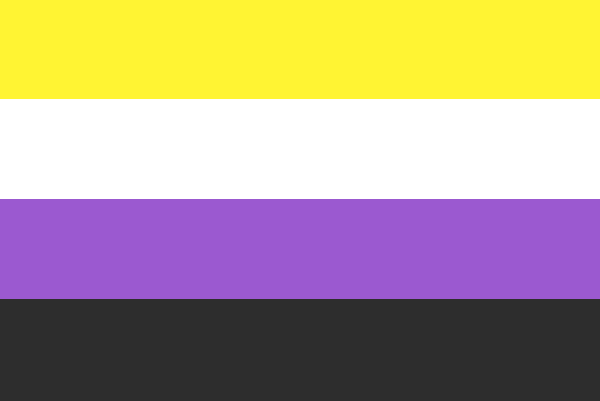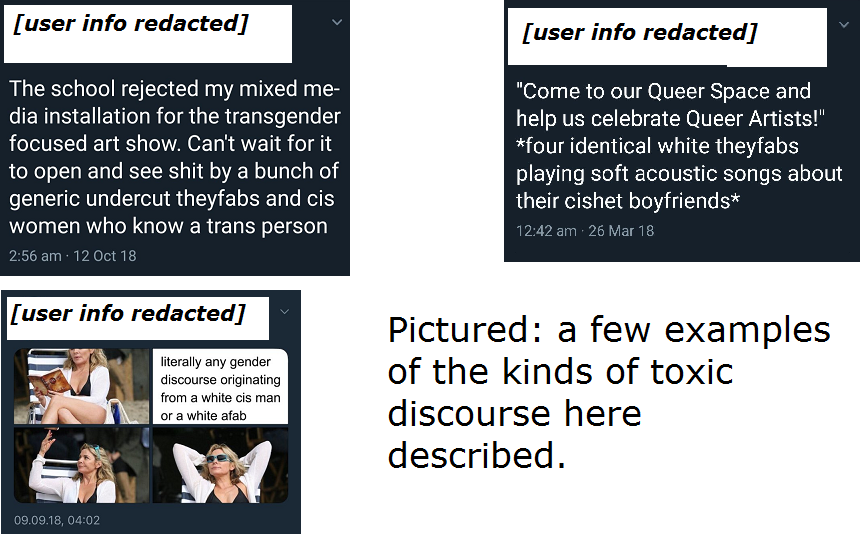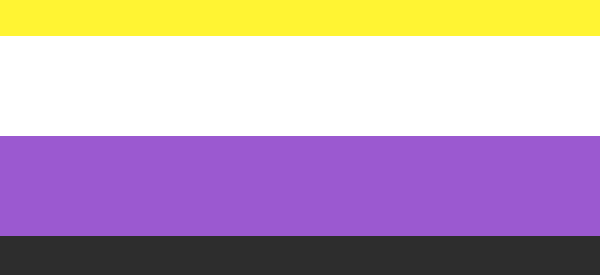One of the most accepting corners of the queer community has a problem accepting its own, and it shows.
 Pictured: the nonbinary pride flag, usually recognized as a subset of transgender identities. (image source: www.genderwiki.com)
Pictured: the nonbinary pride flag, usually recognized as a subset of transgender identities. (image source: www.genderwiki.com)
In discourse both commonplace and academic, the role of transgender people appears to be, inevitably, the exposure of gendered dynamics in our society that are as flimsy as the frontiers of gender itself. Where the common rebuttal to the very existence of trans men is often a histrionic fear that, ?butch women are being pressured into presenting as men,? real debates occur below the surface of such a disingenuous claim; it may have escaped the notice of mainstream society that trans men are men and trans women are women, but the transgender community at large spends more time engaging with the nuances and consequences of these facts rather than the apparently debatable ? it isn?t ? truth of the matter. In order to bring about greater understanding of said nuances and consequences, we must ask of ourselves always an open mind and a polite consideration of the experiences of others which may not have occurred to us, disparate as our lives may be.
The current undercutting this second layer of discussion is the impression of misogyny in our culture. If we simply observe the experiences of trans women who were assigned male at birth, we can see that they ? we, in fact ? do experience misogyny. I, for example, was always a woman, albeit a woman in hiding. As a young girl I did everything that bigots think trans men are being pressured to do; I shut out my own feelings, my own experiences, because the dissonance of these with the way my body and even the narratives I spun with my voice as it deepened with age were received. These are common narratives uniting trans experiences. The euphoria resulting from the actualization of this hidden or suppressed self is a thread running through the entire trans community.
At birth I was called a boy, yet as I was a girl, I experienced misogyny. When I was told to think of girls one way, I thought in a secret place in my mind that I was one of them, and thus the thought applied to me. We speak of this often as an extension of transmisogyny, a certain style of misogyny, to be sure. And yet a trans man growing up as a boy might have had a distinctly different parallel experience. Perhaps misogyny was applied to him by others, but it was not for him in the sense that it was not rhetorically affixed to his identity, his self-concept. And yet, our awareness of misogyny is often rooted in an ethical concern simply for the harm misogyny causes, so we must recognize the harm done there. The experiences of trans men are diverse, and my earnest recommendation to anyone looking to learn more is to go out of your way to search for videos, podcasts, interview, books and articles featuring the lived experiences of trans men to learn more about the diversity of this problem.
 Pictured: Rebecca Sugar, creator of hit cartoon television series ?Steven Universe,? who is also nonbinary. (image source: www.out.com)
Pictured: Rebecca Sugar, creator of hit cartoon television series ?Steven Universe,? who is also nonbinary. (image source: www.out.com)
The rhetoric of anti-queer oppression is fraught with allusions to social power structures, dynamics functioning as hegemonic social strata. The idea that misogyny harms people who aren?t women is far from a new idea; it?s as old as the discussion of toxic masculinity and patriarchy. A narrative where men are to be seen as ever-powerful and never vulnerable neglects their humanity, as well as erasing healthy vulnerabilities that can lead to greater understanding in relationships or better mental health. If we subjugate our girls, we reject the truth of our boys. Training ourselves in a mindset where the feminine is inferior to the masculine may have not-incidental benefits for men, but it is destructive to their humanity.
All this noise about things we already ought to know is to set up a larger point, one here laid bare: the scope of misogyny is more than just a hatred of women; it is also destructive to the feminine more generally, whether this femininity is assigned or identified. It is not just people who choose to present in a feminine way who are denigrated, feminine pursuits are also the subject of derision. Any doubt to this fact is laid to rest by the way our society treats men who are otherwise the epitome of masculinity, a platonic ideal of the manliest man, but who also pursues something, anything deemed conventionally feminine. Femininity, whether he identifies with it or not, is then treated as a curse or a rot corrupting his otherwise unimpeachable masculinity. We also denigrate qualities seen as stereotypically masculine in women, although the difference broadly appears to be that we see women as acting in service of men: carrying their babies, cleaning their house, serving to their sexual pleasure. This is not a healthy concept of gender.
If someone tells you we are living in a post-gender society, you have every permission possible to laugh. Questions of what makes a man or a woman abound, and still more uncharted in public discourse is how one might be neither a man nor a woman.
The simple fact we must admit moving forward is that people who do not identify within the gender binary exist just as much as those who do identify with it exist. These people are commonly called nonbinary, and many other terms are associated with this. Someone who is genderqueer may have a different concept of their gender than is possible within the false binary, and someone who is gender-nonconforming may simply express their gender in an atypical way. Someone who is agender may identify as no gender at all, whereas someone who is genderfluid may express one or more genders at any given time.
As always, more answers lead to more questions. How many ways can we be genderqueer? If a nonbinary person is genderfluid, are they then sometimes not nonbinary? If an agender person is gender-nonconforming, then do they expressly use gendered pronouns and present with varied gendered appearances to present that nonconformity? The answers are as wondrous as the questions, for we find ourselves observing time and time again that there are more genders and ways to be a gender in heaven and earth than there are in our philosophy of gender. A person is worth a thousand words.
 (Image source: wyredproject.eu)
(Image source: wyredproject.eu)
When we allude to these social dynamics, and we invoke paradigms of power, our concern is often for injustices committed. We very typically understand these through oppressor-oppressed narratives. In simple terms, someone gets punched, so someone does the punching, right? But while this simplistic understanding might be useful for understanding how one social group can be privileged above another, it does not map onto trans struggles so easily. I have had the privilege of speaking to a number of trans-masc and nonbinary people who have offered a great deal of insight on this matter. The treatment of all persons who were once assigned female at birth or AFAB in this community is, frankly, disturbing.
When a trans person is presenting as male or masculine, they are pressured to occupy no more an amount of space in any conversation than we are comfortable granting. A result of this is the erasure of the experiences of any and all transmasculine people, men or otherwise. There even exists a social undercurrent of online bullying and bigotry against feminine AFAB trans people.

It must be known that, while it is sometimes pertinent to talk about the experiences of people who were assigned female at birth in the context where you might call them ?AFAB people,? such as in this article, it is otherwise an act of misgendering to call some ?an afab.? AFAB is an acronym that describes a person, it is not a noun itself. To use it in this way is akin to when anti-trans bigots call trans people ?transgenders.? Some of my fellow trans people online would do well to give our nonbinary siblings the same respect we know we deserve. It does not escape notice that basic human respect in trans spaces is readily available primarily to trans people who exist comfortably within the gender binary.
We have taken the long road to get to this point in our discussion because it must be made known in this context that there exists no barrier or separation between being nonbinary and being a man or a woman. Some nonbinary people are also men or women. Some are not. Some are genderfluid and can be one or more. Some merely exist at an axis where these identities or expressions meet. It matters not a little when we consider whether they deserve our respect. The answer is always yes.
There is not a speck of truth to the conspiracy some of my fellow trans women in this community irrationally uphold that AFAB feminine nonbinary people are overrepresented in the trans community, or that they are mistreating trans women en masse. Trans women do carry a great burden of societal mistreatment, it?s true, but if anything there exists a broad social rejection of nonbinary identities every bit as pervasive as transmisogyny. This must cease for the good of the immediate health of our community.
My hope is that this has been an adequate exploration of one conversation within one facet of the trans community. I look forward to supporting my fellow trans siblings and comrades in times to come, as must we all.
[The author, Violet Guinevere Stellar, has more work regarding trans experiences and representation which appears under the name V. G. Stellar in the case of her novels and Violet Stellar in the case of her poetry chapbooks, including ?Dysphoria & Blood,? a poetic account of her adolescence and young adult experience coming to terms with her identity.]


